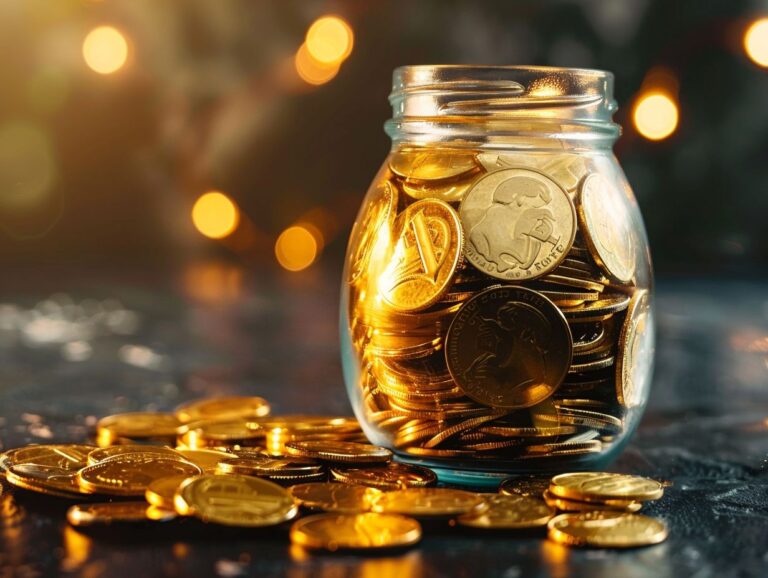- Our content is independently written and reviewed by trusted reviewers & fact-checkers.
- Your information is never sold. We can earn money by connecting you with top Gold IRA Companies. Learn how our reviews work.
- Want to learn more? Meet our authors and explore our editorial policy.

Gold, admired for its beauty, malleability, and durability, has long held significant value. Today, the precious metal remains an important asset for central banks, and it serves as a safe haven during times of economic instability.
But how much gold does each country actually have locked away in vaults? What countries hold the most gold, and how much gold do these countries actually have?
Here we look at the top countries with the largest gold reserves in the world and why these precious metal holdings are so significant.
Table of Contents
Top 5 Countries With Largest Gold Reserves in the World
#1: United States
The United States holds the largest official gold reserves in the world. As of January 2023, the U.S. gold reserve amounted to over 8,133 metric tons, which represents about 78% of its total foreign reserves.
The Federal Reserve holds most of the U.S. government’s gold reserves, with the remaining held at the U.S. Mint. Fort Knox, Kentucky, is where the U.S. holds its gold bullion depository.
The U.S. gold reserve reached its peak of over 20,000 metric tons during World War II. However, the reserve declined sharply during the 1960s as the U.S. Treasury liquidated parts of its reserve for deficit spending and to stabilize the dollar. The peg of USD to gold was eventually eliminated in 1971.
Over the last decade, the U.S. gold reserve has remained relatively steady, around 8,000-9,000 metric tons. Maintaining large gold reserves helps bolster both domestic and international confidence in the strength of the U.S. dollar as a global reserve currency.
#2: Germany
Germany currently holds the second largest gold reserves in the world after the United States. As of January 2023, the German central bank, known as the Deutsche Bundesbank, holds 3,352 tonnes of gold reserves valued at approximately $150 billion USD.
The country’s gold reserves are stored in three different locations, that is, Frankfurt, New York, and London. This provides security through geographic diversification and safeguards against geopolitical risks.
The storage facility in Frankfurt is managed by the Deutsche Bundesbank. It stores half of Germany’s gold reserves locally in Frankfurt. Storing a significant portion domestically gives Germany direct access and control over part of its reserves.
#3: Italy
Italy, while not matching the golden giants like the United States or Germany, has still amassed a remarkable treasure in gold reserves.
As of 2023, Italy proudly holds 2,451.8 metric tons of gold, positioning it as the world’s third-largest holder of this precious metal. This impressive stash translates to a dazzling $130 billion in value at current market prices.
The majority of Italy’s gold reserves are held domestically, with 74% stored at the Bank of Italy in Rome, which contrasts with many other nations who store their gold reserves abroad.
While countries like the U.S. and Germany have shown a significant increase in their gold reserves, data shows that Italy’s gold reserves have remained relatively stable in the last few decades.
#4: France
France currently holds 2,436 metric tons of gold in reserves, making it the 4th largest gold reserve in the world. The Banque de France manages the country’s official gold reserves and stores the gold bars within its vaults in Paris.
Most of the gold was accumulated in the 1950s and 1960s, but France has continued to make small purchases in recent years to expand its reserves. While France has the 4th largest gold holdings globally, its reserves only account for 7.2% of the world’s total known gold reserves.
#5: Russia
Russia’s gold reserves, ranking fifth globally, are a treasure trove with more than 2,333 metric tons, valued at over $140 billion. This golden wealth forms a significant chunk—about 20% of Russia’s foreign currency reserves. This proportion is notably higher compared to many countries.
Looking back to the early 2000s, Russia’s gold stash was a modest 340 tons. But over the last two decades, there’s been a determined effort by the Russian Central Bank to grow this golden cache.
They’ve been buying up domestic gold and ramping up production. The result? A glittering increase: from 2018 to 2023, Russia’s gold reserves more than doubled, soaring from around 1,800 metric tons to the impressive current figure.
Other Notable Countries
While the top 5 countries hold the largest gold reserves, there are a few other countries with sizable gold reserves worth mentioning.
- China currently holds the 6th largest gold reserves in the world, with total reserves estimated to be around 2113 metric tons as of 2023. This positions China just behind Russia.
- Switzerland holds the 7th largest gold reserves in the world, with total reserves estimated to be around 1,040 tonnes.
- Japan holds the world’s 7th largest gold reserves, estimated at about 846 tonnes. The Bank of Japan holds 80% of the country’s gold, with the rest held privately.
- India also holds a significant amount of gold reserves, estimated to be the 9th largest in the world. Gold plays an important role culturally and economically in India, with the majority of Indians investing in physical gold, such as jewelry.
Why Gold Reserves Are Important
So why are gold reserves so important?
Here are some of the key reasons:
- Gold tends to hold its value over time, even during economic crises when other assets decline sharply. Having gold reserves can help protect a country’s wealth and provide a cushion in case of emergency.
- Countries with substantial gold reserves are seen as more creditworthy, and their currencies are seen as more stable. They are also seen as an indicator of financial health and stability.
- Gold is universally valued and accepted around the world. Holdings of gold reserves allow countries to make international transactions and stabilize trade balances.
- The top gold holders, like the US and Germany, have additional power in setting global policies, trade deals, and interest rates. Their large gold reserves strengthen their positions.
- Gold maintains its value over the long-term, unlike national currencies, which are prone to losing value through inflation.
- Gold provides an important alternative to assets like stocks, bonds, and currencies. The price of gold often moves independently of other markets, so it enhances diversification.
Final Thoughts
While global gold reserves are distributed unevenly, they represent the enduring value and appeal of this precious metal. For leading nations, gold remains an essential economic asset and a symbol of wealth and power.
As gold maintains its universal prestige, national reserves are likely to persist as pillars of economic policy for the foreseeable future.
Frequently Asked Questions
Which Countries Have the Least Gold Reserves?
Fiji, Yemen, Haiti, and Suriname, among other countries, have the least notable gold reserves.
How Much Gold Should a Country Hold in Reserves?
There are no universal rules on ideal gold reserve levels. It varies by the size and strength of a country’s economy, financial system, and monetary policy goals.
Many advise holding enough gold to cover at least 3 months of imports or to back 20-30% of monetary assets. But ultimately, it is a national decision based on economic and geopolitical factors.
Where Is Most of the National Gold Stored?
Most gold reserves are held domestically in a nation’s central bank vaults and bullion depositories. This allows easy access if needed. Some countries also store gold abroad in foreign central bank vaults, such as the Federal Reserve Bank of New York or the Bank of England. This provides geopolitical diversification.
Why Does the U.S. Have So Much Gold?
The U.S. holds a substantial amount of gold reserves primarily for economic and symbolic reasons. Economically, large gold reserves underpin the confidence in the U.S. dollar, acting as an insurance against economic uncertainties.
Symbolically, vast gold reserves demonstrate the country’s wealth and economic power on the global stage, thereby enhancing its geopolitical influence.
Article Sources
At Gold IRA Blueprint, we dive deep into the world of gold IRAs, using trusted sources to back up our insights. Our sources range from official documents to expert interviews, ensuring our content is both accurate and reliable. We also draw on research from reputable publishers to give you the most comprehensive understanding possible. Check out our editorial policy to see how we maintain our high standards for accuracy and fairness. Also make sure to check out our Financial Review Process to have a better understanding of our process.
- Trading Economics (n.d. ) Gold Reserves. Retrieved from https://tradingeconomics.com/country-list/gold-reserves.
- Forbes (2024, Jan.) Top 20 countries with largest gold reserves [Q3 2023]. Retrieved from https://www.forbesindia.com/article/explainers/gold-reserves-by-country/90127/
- Statista (n.d.) Gold reserves of largest gold holding countries worldwide as of 2nd quarter 2023. Retrieved from https://www.statista.com/statistics/267998/countries-with-the-largest-gold-reserves/














